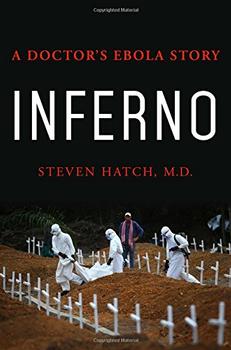Summary | Excerpt | Reviews | Beyond the Book | Readalikes | Genres & Themes | Author Bio

A Doctor's Ebola Story
by Steven Hatch
Ebola became one of a number of viruses that would earn the moniker of "emerging infectious diseases," although the term itself indicates the hubris by which Homo sapiens sometimes regard our world. The virus had hardly "emerged"; it's just that we finally happened to stumble upon it and identify it for what it was. What we now call Ebola has without any doubt been around for thousands of years, probably tens of thousands. Although much of what we know about Ebola is provisional and therefore subject to wide ranges of interpretation, we're reasonably sure that the virus has circulated among fruit bats for millennia in much the same way that cold viruses circulate among humans—that is, it might make them sick, but not ever sick enough to do any real harm. A virus has an interest in not making its host too sick, because then it can survive in a happy equilibrium by making copies of itself and continuing to survive as long as it has plenty of hosts to which it can spread. It has no interest in killing its primary host—or at least killing it quickly—since then it can't spread and will ensure its own demise. But when a virus jumps a species, and it happens to be deadly to that other animal, all bets are off.
The fruit bat may be Ebola's "natural reservoir"—the creature in which the virus finds its primary home—although, again, nobody is completely certain of that. Unlike many other viruses, whose place in nature scientists have been able to deduce from careful field studies, Ebola for all its ferocity has been something of a shy predator, disappearing back into the jungle as quickly as it materializes, making itself seemingly invisible despite decades of animal testing conducted on the creatures who live at the site of the outbreaks. It wasn't until 2005—after nearly three decades of seriously funded, high-level research—that scientists were able to spot the genetic signature of Ebola in the blood of fruit bats, which provided indirect evidence that the bats were its natural home. Four years later, Ebola's sibling, the Marburg virus, was isolated in fruit bats. Thus far, three species have been proven to possess the virus: the hammer-head bat, or Hypsignathus monstrosus; the little collared fruit bat, or Myonycteris torquata; and finally, the elaborately named Franquet's epauletted fruit bat, or Epomops franqueti. Fruit bats are fairly endearing creatures, with humanlike faces and a soft fur on all but their wings. They are commonly called "flying foxes" based on their resemblance. But the bats believed to be nesting in the tree in Meliandou were not fruit bats at all and aren't especially cute. Yet the close proximity of Mops condylurus to Emile Ouamouno seemed suggestive, although subsequent research on bats captured in the area found no evidence of current or prior infection. The bat-origin hypothesis could not be confirmed, becoming another tantalizing clue in a complex puzzle, and much about how the virus behaves in its natural environment remains completely unknown.
Ebola got its name by a slight bending of the rules of virus nomenclature on the part of the scientists who discovered it. The Zaire outbreak in 1976 began in a Catholic mission hospital in a village known as Yambuku. The hospital saw the first patients of this distinct and novel disease, more than twenty in all. Nearly all of them died, which led the staff doctor to alert the Zairean Ministry of Health, who sent a team to investigate and found the hospital closed because the staff themselves had become sick. The medical staff too nearly all died. This was what prompted the government of Zaire to call for the international response that led to the collection of blood samples and eventual isolation of the virus. Traditionally, viruses such as these are named based on the location where the first cases are identified. Marburg's natural reservoir, for instance, is in Africa, but it is named after the German town where the first known human cases of the disease occurred, in animal workers handling African green monkeys. Similarly, at nearly the same time the patients in Yambuku were dying, a group of teenagers in a small town in Connecticut had become moderately ill with a disease that would eventually be proven to be bacterial in origin, but the scientists applied the same "viral" rule of naming it after the site of its discovery. The town's name is Lyme.
Excerpted from Inferno by Steven Hatch. Copyright © 2017 by Steven Hatch. Excerpted by permission of St. Martin's Press. All rights reserved. No part of this excerpt may be reproduced or reprinted without permission in writing from the publisher.
Your guide toexceptional books
BookBrowse seeks out and recommends the best in contemporary fiction and nonfiction—books that not only engage and entertain but also deepen our understanding of ourselves and the world around us.